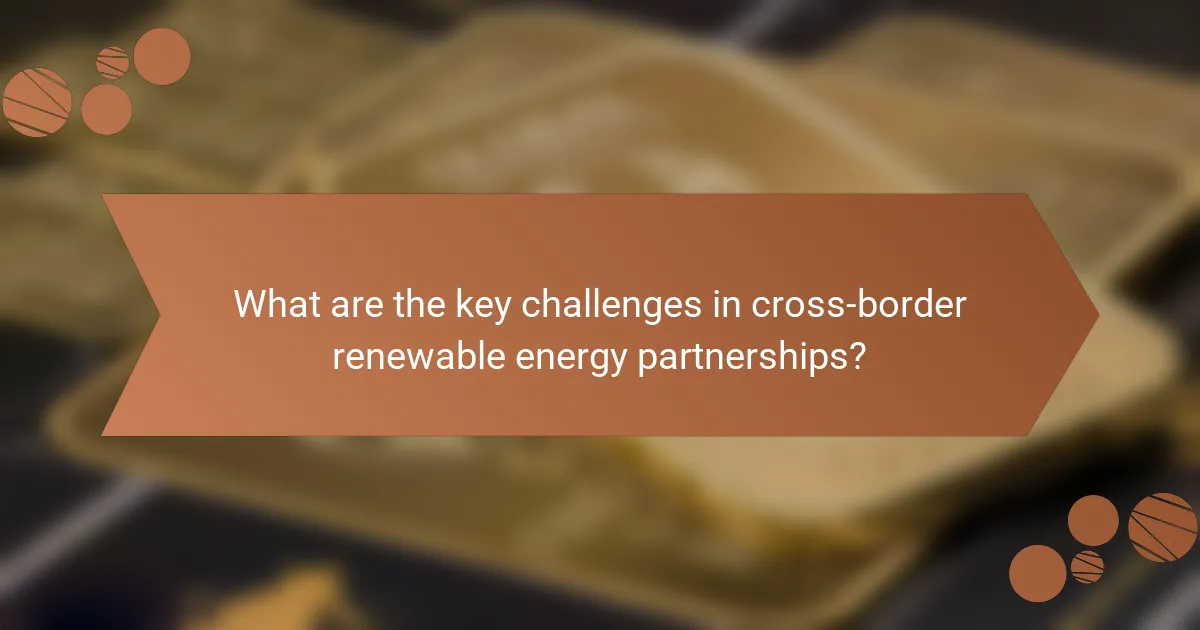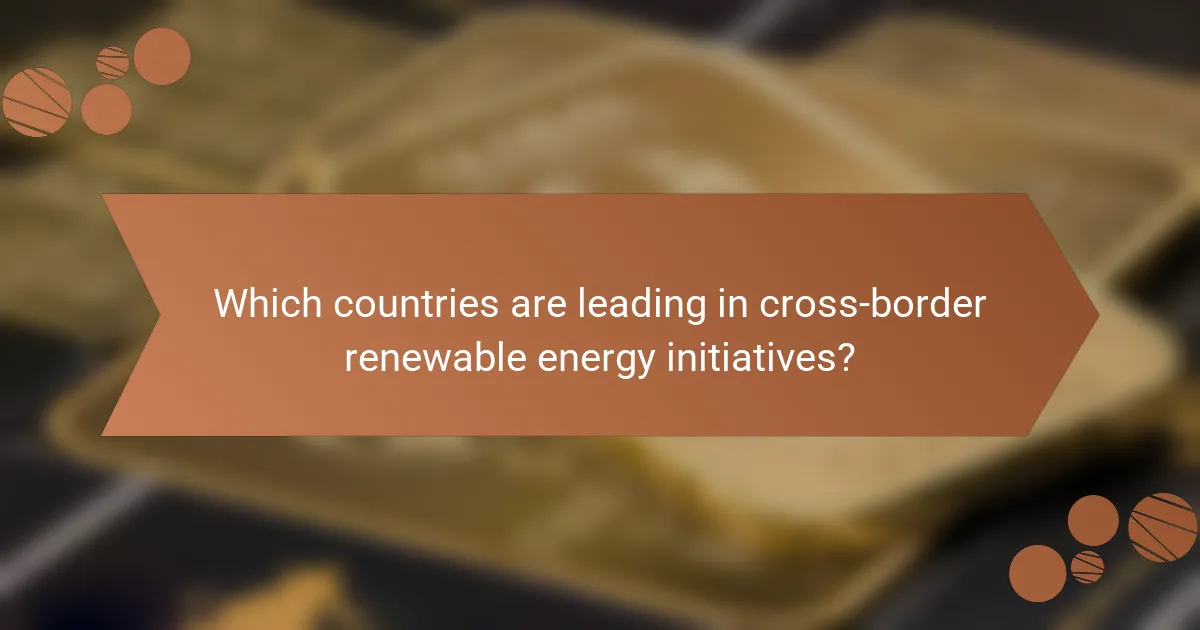Cross-border partnerships in renewable energy present a unique opportunity for countries to collaborate on sustainable projects that enhance energy security and efficiency. By pooling resources and sharing technological advancements, these alliances can drive economic growth while addressing common energy challenges. However, navigating regulatory barriers and cultural differences remains crucial for the success of such initiatives.

What are the benefits of cross-border renewable energy partnerships?
Cross-border renewable energy partnerships offer numerous advantages, including improved energy efficiency, access to a variety of resources, and enhanced technological collaboration. These partnerships can significantly contribute to energy security and stimulate economic growth in participating countries.
Increased energy efficiency
Cross-border partnerships can lead to increased energy efficiency by optimizing resource allocation and reducing waste. By sharing infrastructure and technology, countries can minimize energy losses during transmission and distribution.
For example, a country with abundant solar energy can supply neighboring regions during peak demand, reducing reliance on less efficient fossil fuels. This synergy not only enhances efficiency but also lowers overall energy costs.
Access to diverse resources
These partnerships provide access to a wider range of renewable energy resources, such as wind, solar, hydro, and geothermal energy. Countries can leverage their unique geographic advantages to complement each other’s energy portfolios.
For instance, a nation with strong wind resources can collaborate with one that has significant solar potential, allowing both to benefit from a more balanced and reliable energy supply throughout the year.
Enhanced technological exchange
Cross-border partnerships facilitate the exchange of innovative technologies and best practices in renewable energy. This collaboration can accelerate the adoption of advanced solutions, such as smart grids and energy storage systems.
Countries can learn from each other’s experiences, leading to improved project outcomes and reduced costs. For example, a country that has successfully implemented offshore wind farms can share its expertise with a neighboring nation looking to develop similar projects.
Improved energy security
By diversifying energy sources and suppliers, cross-border partnerships enhance energy security for participating nations. This reduces vulnerability to supply disruptions and price volatility associated with single-source dependencies.
For example, if one country faces a natural disaster affecting its energy production, neighboring countries can provide backup support, ensuring a stable energy supply across borders.
Economic growth opportunities
Cross-border renewable energy partnerships can stimulate economic growth by creating jobs and attracting investments in clean energy projects. These collaborations often lead to the development of new markets and industries.
Countries can benefit from shared investments in infrastructure, which can lower costs and enhance competitiveness. For instance, joint ventures in renewable energy projects can lead to job creation in construction, maintenance, and technology sectors, boosting local economies.

How do cross-border renewable energy partnerships work?
Cross-border renewable energy partnerships involve collaboration between countries to develop, finance, and implement renewable energy projects. These partnerships leverage shared resources, technology, and regulatory frameworks to enhance energy security and sustainability across borders.
Collaborative project development
Collaborative project development in cross-border renewable energy partnerships typically involves joint planning and execution of energy projects, such as wind farms or solar plants. Countries can share expertise, technology, and infrastructure, which can lead to more efficient project timelines and reduced costs.
For instance, a partnership between two neighboring countries might focus on building a solar power plant that utilizes land and resources from both sides, optimizing the use of available sunlight and reducing the overall environmental impact.
Regulatory alignment
Regulatory alignment is crucial for the success of cross-border renewable energy partnerships. This involves harmonizing regulations, standards, and policies to facilitate smoother project implementation and operation. Countries must navigate differences in energy laws, permitting processes, and environmental regulations.
For example, if one country has stringent emissions standards while another has more lenient regulations, aligning these can help avoid legal conflicts and streamline project approvals. Establishing a common framework can also enhance investor confidence.
Joint financing models
Joint financing models are essential for funding cross-border renewable energy projects. These models can include public-private partnerships, where governments and private investors share the financial burden, or international financing institutions that provide loans or grants.
Countries may also explore innovative financing mechanisms, such as green bonds or blended finance, to attract investment. For instance, a partnership might issue green bonds to fund a shared wind energy project, appealing to environmentally conscious investors while providing necessary capital.

What are the key challenges in cross-border renewable energy partnerships?
Cross-border renewable energy partnerships face several key challenges that can hinder their effectiveness. These include regulatory barriers, infrastructure limitations, cultural differences, and market volatility, all of which require careful navigation to ensure successful collaboration.
Regulatory barriers
Regulatory barriers often pose significant challenges in cross-border renewable energy partnerships. Different countries have varying laws, standards, and policies that can complicate project development. For example, obtaining permits may take longer in one country compared to another, leading to delays and increased costs.
To mitigate these issues, partners should conduct thorough research on the regulatory landscape of each country involved. Engaging with local legal experts can provide insights into compliance requirements and help streamline the approval process.
Infrastructure limitations
Infrastructure limitations can severely impact the feasibility of cross-border renewable energy projects. Inadequate transmission lines, outdated grid systems, or lack of access to necessary technologies can hinder energy transfer between countries. For instance, if one country has advanced wind farms but lacks the infrastructure to export that energy, the partnership may falter.
Investing in infrastructure improvements or leveraging existing networks can alleviate some of these limitations. Collaborating with local governments or utility companies may also provide opportunities for shared investments in necessary upgrades.
Cultural differences
Cultural differences can affect communication and collaboration in cross-border renewable energy partnerships. Variations in business practices, decision-making processes, and stakeholder engagement can lead to misunderstandings or conflicts. For example, a more hierarchical approach in one country may clash with a collaborative style in another.
To address these challenges, fostering open communication and cultural awareness is essential. Regular meetings and team-building activities can help bridge cultural gaps and create a more cohesive partnership.
Market volatility
Market volatility can create uncertainty in cross-border renewable energy partnerships, affecting investment decisions and project viability. Fluctuations in energy prices, changes in government incentives, or shifts in consumer demand can impact the financial stability of projects. For instance, a sudden drop in fossil fuel prices may reduce the competitiveness of renewable energy sources.
To navigate market volatility, partners should develop flexible business models that can adapt to changing conditions. Regular market analysis and risk assessment can help identify potential threats and inform strategic adjustments to maintain project sustainability.

Which countries are leading in cross-border renewable energy initiatives?
Germany, France, Norway, Sweden, the United States, and Canada are at the forefront of cross-border renewable energy initiatives. These countries have established collaborative frameworks to enhance energy security, share resources, and meet climate goals through interconnected energy systems.
Germany and France
Germany and France have developed a robust partnership in renewable energy, particularly in wind and solar power. The two countries collaborate on projects like the North Sea Wind Power Hub, which aims to connect multiple countries through a shared offshore wind farm network.
Key considerations include regulatory alignment and grid integration. Both nations have established frameworks to facilitate energy trading, allowing for efficient distribution and utilization of renewable resources across borders.
Norway and Sweden
Norway and Sweden lead in hydropower and wind energy collaboration, leveraging Norway’s extensive hydropower capacity and Sweden’s wind energy investments. The Nordic electricity market enables seamless energy trading, which enhances reliability and reduces costs.
Both countries benefit from shared infrastructure and policies that promote sustainability. The interconnections between their grids allow for efficient energy exchange, especially during peak demand periods.
United States and Canada
The United States and Canada have a long-standing partnership in renewable energy, focusing on hydropower, wind, and solar energy. The two countries share resources through agreements like the U.S.-Canada Clean Energy Dialogue, which aims to enhance cooperation in clean energy technologies.
Practical steps include leveraging existing transmission lines and investing in new infrastructure to facilitate cross-border energy flows. Both nations can benefit from diverse energy portfolios, improving resilience against market fluctuations and environmental impacts.

What criteria should be considered for selecting partners?
Selecting partners for cross-border renewable energy projects involves evaluating several key criteria that ensure compatibility and effectiveness. Critical factors include technical expertise, financial stability, regulatory compliance, and cultural alignment.
Technical expertise
Technical expertise is essential when selecting partners in the renewable energy sector. This includes knowledge of specific technologies, such as solar, wind, or hydroelectric systems, as well as experience in project management and implementation. Assessing a partner’s past projects can provide insight into their capabilities.
Consider the partner’s certifications and adherence to industry standards, such as ISO certifications or local regulations. A partner with a strong technical background can help mitigate risks and enhance project efficiency. Look for partners who have successfully completed similar projects in the region to ensure they understand local conditions and challenges.
Additionally, evaluate their innovation track record. A partner that invests in research and development may offer advanced solutions that can improve project outcomes and reduce costs. Prioritize partners who demonstrate a commitment to sustainability and environmental responsibility, as this aligns with the goals of renewable energy initiatives.



